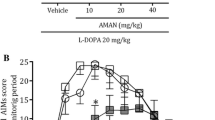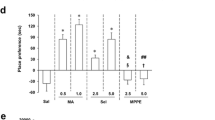Abstract
Effects of neuronal nitric oxide synthase (nNOS) inhibitor (7-nitroindazole), nonselective NOS inhibitor (NG-nitro-L-arginine methyl ester; L-NAME), and monoamine oxidase inhibitor (pargyline) were studied on 1-methyl-4-phenyl-1,2,3,6-tetrahydropyridine (MPTP)-treated mice. The mice received four intraperitoneal injections of MPTP at 1-h intervals. A significant depletion in dopamine and DOPAC concentration was observed in the striatum from 1 day after MPTP treatment. The pretreatment of 7-nitroindazole and pargyline, but not L-NAME, dose-dependently protected against MPTP-induced depletion in dopamine content 3 days after MPTP treatment. Our histochemical study also showed that 7-nitroindazole and pargyline can prevent a marked decrease in the nigral cells and a marked increase in astrocytes in striatum 7 days after MPTP treatment. The protective effect of 7-nitroindazole against MPTP-induced dopamine and DOPAC depletion in the striatum was not attenuated by intraperitoneal pretreatment with L-arginine. Furthermore, the posttreatment of 7-nitroindazole or pargyline protected against MPTP-induced depletion of dopamine content. These results demonstrate that the protective mechanism by which 7-nitroindazole counteracts MPTP neurotoxicity in mice may be due not only to inhibition of nNOS, but also to MAO-B inhibition. Furthermore, our study suggests that the posttreatment of 7-nitroindazole and pargyline can prevent a significant decrease in dopamine levels in the striatum of MPTP-treated mice. These findings have important implications for the therapeutic time window and choice of nNOS or MAO inhibitors in patients with Parkinson's disease.
Similar content being viewed by others
REFERENCES
Arai, N., Misugi, K., Goshima, Y., and Misu, Y. (1990). Evaluation of a 1-methyl-4-phenyl-1,2,3,6-tetrahydropyridine (MPTP)-treated C57 black mouse model of parkinsonism. Brain Res. 515:57-63.
Araki, T., Kato, H., Shuto, K., and Itoyama, Y. (1998). Alterations in [3H]L-NG-nitroarginine binding in brain after transient global or transient focal ischemia in gerbils and rats. Eur. J. Pharmacol. 354:153-159.
Araki, T., Kumagai, T., Matsubara, M., Ido, T., Imai, Y., and Itoyama, Y. (2000). Protective effect of riluzole on MPTP-induced depletion of dopamine and its metabolite content in mice. Metab. Brain Dis. 15:193-201.
Araki, T., Mikami, T., Tanji, H., Matsubara, M., Imai, Y., Mizugaki, M., and Itoyama, Y. (2001a). Biochemical and immunological changes in the brain of 1-methyl-4-phenyl-1,2,3,6-tetrahydropyridine (MPTP)-treated mouse. Eur. J. Pharm. Sci. 12:231-238.
Araki, T., Mizutani, H., Matsubara, M., Imai, Y., Mizugaki, M., and Itoyama, Y. (2001b). Nitric oxide synthase inhibitors cause motor deficits in mice. Eur. Neuropsychopharmacol. 11:125-133.
Araki, T., Tanji, H., Fujihara, K., Kato, H., and Itoyama, Y. (1999). Increases in [3H]FK-506 and [3H]L-NG-nitroarginine binding in the rat brain after nigrostriatal dopaminergic denervation. Metab. Brain Dis. 14:21-31.
Beckman, J.S., Beckman, T.W., Chen, J., Marshall, P.M., and Freeman, B.A. (1990). Apparent hydroxyl radicals production by peroxynitrite: Implications for endothelial injury from nitric oxide and superoxide. Proc. Natl. Acad. Sci. USA 87:1621-1624.
Beckman, J.S., Ischiropoulos, H., Zhu, L., van der Woerd, M., Smith, C., Chen, J., Harrison, J., Martin, J.C., and Tsai, M. (1992). Kinetics of superoxide dismutase-and iron-catalyzed nitration of phenolics by peroxynitrite. Arch. Biochem. Biophys. 298:438-445.
Bredt, D.S., Hwang, P.M., and Snyder, S.H. (1990). Localization of nitric oxide synthase indicating a neural role for nitric oxide. Nature 347:768-770.
Bredt, D.S., and Snyder, S.H. (1990). Isolation of nitric oxide synthase, a calmodulin-requiring enzyme. Proc. Natl. Acad. Sci. USA 87:682-685.
Bredt, S.H., and Snyder, S.H. (1994). Nitric oxide: A physiologic messenger molecule. Ann. Rev. Biochem. 63:175-195.
Burns, R.S., Chiueh, C.C., Markey, S.P., Ebert, M.H., Jacobowitz, D.M., and Kopin, I.J. (1983). A primate model of parkinsonism: Selective destruction of dopaminergic neurons in the pars compacta of the substantia nigra by N-methyl-4-phenyl-1,2,3,6-tetrahydropyridine. Proc. Natl. Acad. Sci. USA 80:4546-4550.
Castagnoli, K., Palmer, S., Anderson, A., Bueters, T., and Castagnoli, N., Jr. (1997). The neuronal nitric oxide synthase inhibitor 7-nitroindazole also inhibits the monoamine oxidase-B catalyzed oxidation of 1-methyl-4-phenyl-1,2,3,6-tetrahydropyridine. Chem. Res. Toxicol. 10:364-368.
Dawson, V.L., Dawson, T.D., London, E.D., Bredt, D.S., and Snyder, S.H. (1991). Nitric oxide mediate glutamate neurotoxicity in primary cortical culture. Proc. Natl. Acad. Sci. USA 88:6368-6371.
Dawson, T.D., and Snyder, S.H. (1994). Gases as biological messengers: Nitric oxide and carbon monoxide in the brain. J. Neurosci. 14:5147-5159.
Desvignes, C., Bert, L., Vinet, L., Denoroy, L., Renaud, B., and Lambás-Senas, L. (1999). Evidence that the neuronal nitric oxide synthase inhibitor 7-nitroindazole inhibits monoamine oxidase in the rat: In vivo dihydroxyphenylacetic acid. Neurosci. Lett. 261:175-178.
Ferrante, R.J., Hantraye, P., Brouilet, E., and Beal, M.F. (1999). Increased nitrotyrosine immunoreactivity in substantia nigra neurons in MPTP treated baboons is blocked by inhibition of neuronal nitric oxide synthase. Brain Res. 823:177-182.
Gluck, M.R., Krueger, M.J., Ramsey, R.R., Sabin, S.O., Singer, T.P., and Nicklas,W.J. (1994). Characterization of the inhibitory mechanism of 1-methyl-4-phenylpyridinium and 4-phenylpyridine analogs in inner membrane preparation. J. Biol. Chem. 269:3167-3174.
Hantraye, P., Brouillet, E., Ferrante, R., Palfi, S., Dolan, R., Matthews, R.T., and Beal, M.F. (1996). Inhibition of neuronal nitric oxide synthase prevents MPTP-induced parkinsonism in baboons. Nature Med. 2:1017-1021.
Heikkila, R.E., Hess, A., and Duvoisin, R.C. (1984). Dopaminergic neurotoxicity of 1-methyl-4-phenyl-1,2,3,6-tetrahydropyridine in mice. Science 224:1451-1453.
Ignarro, L.J. (1990). Biosynthesis and metabolism of endothelium-derived nitric oxide. Ann. Rev. Pharmacol. Toxicol. 30:535-560.
Ischiropoulos, H., Zhu, L., Chen, J., Tsai, M., Martin, J.C., Smith, C.D., and Beckman, J.S. (1992). Peroxynitrite-mediated tyrosine nitration catalyzed by superoxide dismutase. Arch. Biochem. Biophys. 298:431-437.
Johanneseen, N.J., Sobotka, T.J., Weise, V.K., and Markey, S.P. (1991). Prolonged alterations in canine striatal dopamine metabolism following subtoxic doses of 1-methyl-4-phenyl-1,2,3,6-tetrahydropyridine (MPTP) and 4'-amino-MPTP are linked to the persistence of pyridinium metabolites. J. Neurochem. 57:981-990.
Kidd, E.J., Michel, A.D., and Humphrey, P.P.A. (1995). Autoradiographic distribution of [3H]L-NG-nitro-arginine binding in rat brain. Neuropharmacology 34:63-73.
Liberatore, G.T., Jackson-Lewis, V., Vukosavic, S., Mandir, A.S., Vila, M., McAuliffe, W.G., Dawson, V.L., Dawson, T.M., and Przedborski, S. (1999). Inducible nitric oxide synthase stimulates dopaminergic neurodegeneration in the MPTP model of Parkinson disease. Nature Med. 2:1017-1021.
Lonart, G., and Johanson, K.M. (1992). Inhibitory effects of nitric oxide on the uptake of [3H]dopamine and [3H]glutamate by striatal synaptosomes. J. Neurochem. 63:2108-2117.
Marletta, M.A. (1994). Nitric oxide synthase: Aspects concerning structure and catalysis. Cell 78:927-930.
Matthews, R.T., Yang, L., and Beal, M.F. (1997). S-Methylthiocitrulline, a neuronal nitric oxide synthase inhibitor, protects against malonate and MPTP neurotoxicity. Exp. Neurol. 143:282-286.
Moncada, S., Palmer, P.M., and Higgs, E.A. (1991). Nitric oxide: Physiology, pathology and pharmacology. Pharmacol. Rev. 43:109-142.
Monte, D.A., Royland, J.E., Anderson, A., Castagnoli, K., Castagnoli, N., Jr., and Langston, J.W. (1997). Inhibition of monoamine oxidase contributes to the protective effect of 7-nitroindazole against MPTP neurotoxicity. J. Neurochem. 69:1771-1773.
Murphy, S., Simmons, M.L., Agullo, L., Garcia, A., Feinstein, D.L., Galea, E., Reis, D.J., Mincgolomb, D., and Schwartz, J.P. (1993). Synthesis of nitric oxide in CNS glial cells. Trend. Neurosci. 16:323-328.
Nathan, C., and Xie, Q.W. (1994). Nitric oxide synthases: Roles, tolls, and controls. Cell 78:915-918.
Prast, H., and Philippu, A. (1992). Nitric oxide releases acetylcholine in the basal forebrain. Eur. J. Pharmacol. 216:139-140.
Przedborski, S., Jackson-Lewis, V., Yokoyama, R., Shibata, T., Dawson, V.L., and Dawson, T.D. (1996). Role of neuronal nitric oxide in 1-methyl-4-phenyl-1,2,3,6-tetrahydropyridine (MPTP)-induced dopaminergic neurotoxicity. Proc. Natl. Acad. Sci. USA 93:4565-4571.
Rapisardi, S.C., Warrington, V.O., and Wilson, J.S. (1990). Effects of MPTP on the fine structure of neurons in substantia nigra of dogs. Brain Res. 512:147-154.
Schneider, J.S., and Markham, C.H. (1986). Neurotoxic effects of N-methyl-4-phenyl-1,2,3,6-tetrahydropyridine (MPTP) in the cat. Tyrosine hydroxylase immunohistochemistry. Brain Res. 373:258-267.
Schulz, J.B., Matthews, R.T., Muqit, M.M.K., Browne, S.E., and Beal, M.F. (1995). Inhibition of neuronal nitric oxide synthase by 7-nitroindazole protects against MPTP-induced neurotoxicity in mice. J. Neurochem. 64:936-939.
Tanji, H., Araki, T., Nagasawa, H., and Itoyama, Y. (1999). Differential vulnerability of dopaminergic receptors in the mouse brain treated with MPTP. Brain Res. 824:224-231.
Tipton, K.F., and Singer, T.P. (1993). Advances in our understanding of the mechanisms of the neurotoxicity of MPTP and related compounds. J. Neurochem. 61:1191-1206.
van der Vliet, A., O'Neill, C.A., Halliwell, B., Cross, C.E., and Kaur, H. (1994). Aromatic hydroxylation and nitration of phenylalanine and tyrosine by peroxynitrite. Evidence for hydroxyl radical production from peroxynitrite. FEBS Lett. 339:89-92.
Rights and permissions
About this article
Cite this article
Muramatsu, Y., Kurosaki, R., Mikami, T. et al. Therapeutic Effect of Neuronal Nitric Oxide Synthase Inhibitor (7-Nitroindazole) against MPTP Neurotoxicity in Mice. Metab Brain Dis 17, 169–182 (2002). https://doi.org/10.1023/A:1020025805287
Issue Date:
DOI: https://doi.org/10.1023/A:1020025805287




